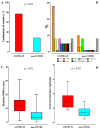Use of Sedatives and Neuromuscular-Blocking Agents in Mechanically Ventilated Patients with COVID-19 ARDS
- PMID: 34835518
- PMCID: PMC8624865
- DOI: 10.3390/microorganisms9112393
Use of Sedatives and Neuromuscular-Blocking Agents in Mechanically Ventilated Patients with COVID-19 ARDS
Abstract
Objectives: To assess differences in the use of analgesics, sedatives and neuromuscular-blocking agents (NMBA) in patients with acute respiratory distress syndrome (ARDS) due to COVID-19 or other conditions.
Methods: Retrospective observational cohort study, single-center tertiary Intensive Care Unit. COVID-19 patients with ARDS (March-May 2020) and non-COVID ARDS patients (2017-2020) on mechanical ventilation and receiving sedation for at least 48 h.
Results: A total of 39 patients met the inclusion criteria in each group, with similar demographics at baseline. COVID-19 patients had a longer duration of MV (median 22 (IQRs 16-29) vs. 9 (6-18) days; p < 0.01), of sedatives administration (18 (11-22) vs. 5 (4-9) days; p < 0.01) and NMBA therapy (12 (9-16) vs. 3 (2-7) days; p < 0.01). During the first 7 days of sedation, compared to non-COVID patients, COVID patients received more frequently a combination of multiple sedative drugs (76.9% vs. 28.2%; p < 0.01) and a higher NMBA regimen (cisatracurium: 3.0 (2.1-3.7) vs. 1.3 (0.9-1.9) mg/kg/day; p < 0.01).
Conclusions: The duration and consumption of sedatives and NMBA was significantly increased in patients with COVID-19 related ARDS than in non-COVID ARDS. Different sedation strategies and protocols might be needed in COVID-19 patients with ARDS, with potential implications on long-term complications and drugs availability.
Keywords: COVID-19; acute respiratory distress syndrome; neuromuscular-blocking agents; sedation.
Conflict of interest statement
The authors declare no conflict of interest.
Figures



Similar articles
-
Best evidence in critical care medicine: The role of neuromuscular blocking drugs in early severe acute respiratory distress syndrome.Can J Anaesth. 2012 Jan;59(1):105-8. doi: 10.1007/s12630-011-9615-2. Epub 2011 Nov 1. Can J Anaesth. 2012. PMID: 22042702
-
A Comparison of Midazolam and Propofol for Deep Sedation in Patients with Acute Respiratory Distress Syndrome Requiring Neuromuscular Blocking Agents.J Pharm Pract. 2024 Apr;37(2):271-278. doi: 10.1177/08971900221131420. Epub 2022 Oct 2. J Pharm Pract. 2024. PMID: 36189765
-
Effect of Neuromuscular Blocking Agents on Sedation Requirements in Trauma Patients with an Open Abdomen.Pharmacotherapy. 2019 Mar;39(3):271-279. doi: 10.1002/phar.2225. Epub 2019 Feb 27. Pharmacotherapy. 2019. PMID: 30672000
-
How to Manage Withdrawal of Sedation and Analgesia in Mechanically Ventilated COVID-19 Patients?J Clin Med. 2021 Oct 24;10(21):4917. doi: 10.3390/jcm10214917. J Clin Med. 2021. PMID: 34768436 Free PMC article. Review.
-
Neuromuscular blocking agents in acute respiratory distress syndrome: updated systematic review and meta-analysis of randomized trials.Intensive Care Med Exp. 2020 Oct 23;8(1):61. doi: 10.1186/s40635-020-00348-6. Intensive Care Med Exp. 2020. PMID: 33095344 Free PMC article. Review.
Cited by
-
Early spontaneous breathing for acute respiratory distress syndrome in individuals with COVID-19.Cochrane Database Syst Rev. 2022 Jun 29;6(6):CD015077. doi: 10.1002/14651858.CD015077. Cochrane Database Syst Rev. 2022. PMID: 35767435 Free PMC article.
-
Neuromuscular Blockade in the Pre- and COVID-19 ARDS Patients.J Pers Med. 2022 Sep 19;12(9):1538. doi: 10.3390/jpm12091538. J Pers Med. 2022. PMID: 36143323 Free PMC article. Review.
-
Association between (ΔPaO2/FiO2)/PEEP and in-hospital mortality in patients with COVID-19 pneumonia: A secondary analysis.PLoS One. 2024 May 31;19(5):e0304518. doi: 10.1371/journal.pone.0304518. eCollection 2024. PLoS One. 2024. PMID: 38820377 Free PMC article.
-
Trends in the Use of Sedative-Hypnotics, Opioids, and Neuromuscular Blockers in Hospitalized Patients During the COVID-19 Pandemic: Observational Retrospective Study.Drugs Real World Outcomes. 2022 Dec;9(4):629-638. doi: 10.1007/s40801-022-00337-z. Epub 2022 Nov 3. Drugs Real World Outcomes. 2022. PMID: 36329371 Free PMC article.
-
Editorial of Special Issue "The COVID-19 Pandemic and Bacterial Infections: Microbiological and Clinical Aspects".Microorganisms. 2023 Apr 12;11(4):1009. doi: 10.3390/microorganisms11041009. Microorganisms. 2023. PMID: 37110433 Free PMC article.
References
-
- Kim L., Garg S., O’Halloran A., Whitaker M., Pham H., Anderson E.J., Armistead I., Bennett N.M., Billing L., Como-Sabetti K., et al. Risk Factors for Intensive Care Unit Admission and In-hospital Mortality Among Hospitalized Adults Identified through the US Coronavirus Disease 2019 (COVID-19)-Associated Hospitalization Surveillance Network (COVID-NET) Clin. Infect. Dis. 2020;72:e206–e214. doi: 10.1093/cid/ciaa1012. - DOI - PMC - PubMed
-
- Di Castelnuovo A., Bonaccio M., Costanzo S., Gialluisi A., Antinori A., Berselli N., Blandi L., Bruno R., Cauda R., Guaraldi G., et al. Cardiovascular risk factors and in-hospital mortality in 3,894 patients with COVID-19: Survival analysis and machine learning-based findings from the multicentre Italian CORIST Study. Nutr. Metab. Cardiovasc. Dis. 2020;30:1899–1913. doi: 10.1016/j.numecd.2020.07.031. - DOI - PMC - PubMed
-
- Taccone F.S., Van Goethem N., De Pauw R., Wittebole X., Blot K., Van Oyen H., Lernout T., Montourcy M., Meyfroidt G., Van Beckhoven D. The role of organizational characteristics on the outcome of COVID-19 patients admitted to the ICU in Belgium. Lancet Reg. Health Eur. 2021;2:100019. doi: 10.1016/j.lanepe.2020.100019. - DOI - PMC - PubMed
LinkOut - more resources
Full Text Sources
Miscellaneous

